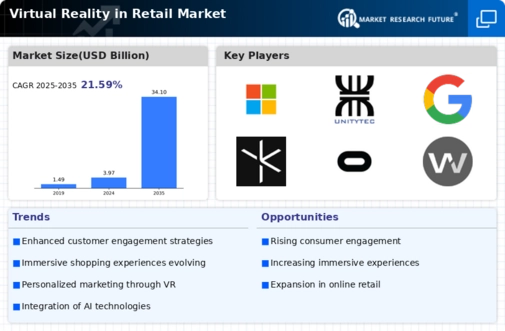Top Industry Leaders in the Virtual Reality Retail Market

Stepping into the Virtual: Analyzing the Competitive Landscape of VR in Retail
The retail industry is witnessing a fascinating transformation, with virtual reality (VR) emerging as a powerful tool to enhance customer experience, drive sales, and redefine brand engagement. This analysis delves into the dynamic VR in retail market, exploring key players, their strategies, and the factors shaping market share.
Key Players:
- Google (US)
- Magic Leap (US)
- Marxent Labs LLC (US)
- Microsoft (US)
- Oculus VR (US)
- WorldViz (US)
- Firsthand Technology Inc. (US)
- HTC Corporation (Taiwan)
- Unity Technologies (US)
- Wevr (US)
Factors for Market Share Analysis:
-
VR Hardware and Software Ecosystem: Availability of affordable, user-friendly VR headsets and intuitive software platforms is crucial for widespread adoption. Players with robust hardware-software integrations will gain traction. -
Content Creation and Quality: Compelling and engaging VR experiences are essential for customer engagement. Companies with expertise in developing high-quality 3D product models and interactive virtual environments will stand out. -
Integration with Existing Retail Operations: Seamless integration of VR technology with existing inventory management, customer relationship management, and sales systems is necessary for efficient implementation. Players facilitating smooth integration will attract retailers. -
Focus on Specific Retail Segments: Catering to the unique needs of different retail sectors like furniture, apparel, or automotive industries through customized VR solutions will create competitive advantage.
Current Company Investment Trends:
-
Focus on Cloud-based VR Solutions: Cloud-based platforms eliminate the need for high-end hardware, making VR more accessible for both retailers and customers. Companies offering scalable and cost-effective cloud VR solutions will gain market share. -
Collaboration and Partnerships: Strategic partnerships between VR technology providers, retailers, and content creators are accelerating innovation and driving wider adoption. Companies fostering diverse collaborations will thrive. -
Omnichannel Integration: Blending physical and virtual retail experiences is becoming increasingly important. Companies developing VR solutions that seamlessly integrate with online and offline channels will offer a holistic customer experience. -
Focus on Data and Analytics: Leveraging VR data to gain insights into customer behavior, preferences, and product engagement is crucial for optimizing VR experiences and driving sales. Companies prioritizing data-driven decision making will stand out.
Latest Company Updates:
-
Rising Adoption: VR in retail is gaining traction, with major retailers like Walmart, Nike, and IKEA experimenting with the technology.
-
Virtual Showrooms: Brands like Lowe's and Wayfair are using VR to create virtual showrooms where customers can explore different home design options and see how products would look in their own homes.
-
Virtual Try-Ons: Retailers like Macy's and Sephora are using VR to allow customers to virtually try on clothes and makeup.

